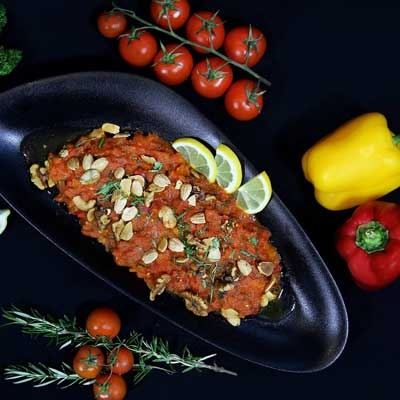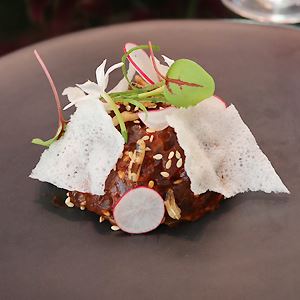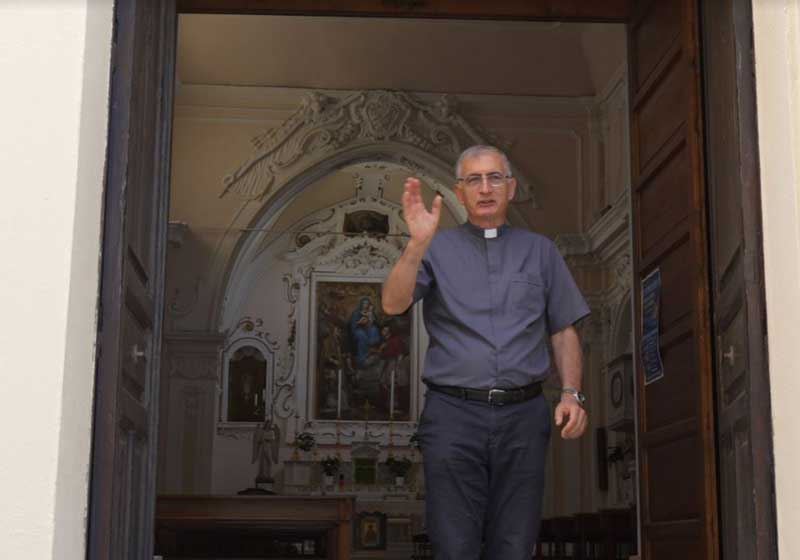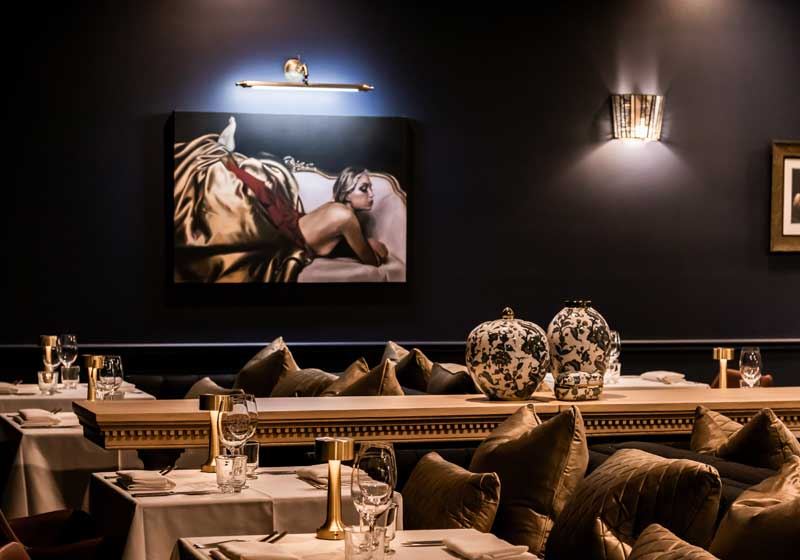
Pan-fried Smoked Kangaroo with Floral Spices - Recipe by Helly Raichura
Ingredients
400 g kangaroo striploin (see Notes, overleaf)
2 Tbs ghee
1 leaf of edible silver, to garnish
Garam masala:
75 g whole black peppercorns
20 g cinnamon stick
25 g black cardamom pods
50 g green cardamom pods
75 g whole cloves
Kangaroo tail sauce:
10 g ghee
200 g kangaroo tail
3 garlic cloves, crushed
2.5 cm piece fresh ginger, peeled and crushed
1 leek, roughly chopped
1 tsp Garam masala
1 tsp whole black peppercorns
1 deep-fried shallot blended into a paste with a little water
Marinade:
25mLpineapple juice
100 g sour cream
1 tsp garam masala
2 tsp ground coriander
15 g minced ginger
25 g minced garlic
Smoking:
Paperbark (available from suppliers of native Australian ingredients), shredded
30 g ghee
Parsnip purée:
200 g parsnip, diced
400mL full-cream (whole) milk
1 fresh bay leaf
2 g ground white pepper
50 g butter
1/2 Tbs rosewater
5mL apple-cider vinegar
5 g caster sugar
Riberries:
50 g sugar
25 g riberries
Notes:
Any red meat can be used instead of kangaroo and plums can be used instead of riberries.
Method
Preheat the oven to 120 C.
To make the garam masala, toast all the spices in a dry frying pan over a low heat for 7-8 minutes. Take off the heat and leave to cool, then grind to a ?ne powder in a spice grinder.
Next, make the kangaroo tail sauce. Heat the ghee in a large cast-iron pot over a high heat.
Once hot, add the kangaroo tail and caramelise on all sides, then add all the remaining ingredients, except the shallot paste and cook for 10 minutes until the leek takes on a bit of colour. Remove from the heat.
Add 500mL water to the pot, cover and transfer to the oven. Cook for 4 hours.
Remove from the oven and strain the broth through a ?ne-mesh sieve into a clean saucepan. (The kangaroo tail can be enjoyed as a meal on its own.) Add the shallot paste and place over a medium heat. Simmer for 10 minutes to reduce the broth to a buttermilk consistency. Season to taste.
Flatten the striploin with a meat mallet until it is 5 mm thin.
Combine all the ingredients for the marinade in a bowl. Add the striploin to a deep roasting tin and cover with the marinade.
Next, smoke the kangaroo. Make a little bowl with a piece of aluminium foil and place it in the tray with the kangaroo. Add the shredded paperbark to the bowl and light it. Pour the ghee on top to create smoke. Once the ?ame dies down, quickly cover the tray with another piece of foil and leave to smoke for 15 minutes.
Preheat the oven to 150 C.
To make the parsnip purée, place the parsnip in a roasting tin with the milk, bay leaf, white pepper and salt, to taste. Cover with foil and bake for 15-20 minutes, or until the parsnip is soft.
Remove the bay leaf, transfer the mixture to a blender and blitz to a smooth paste. Add the butter, rosewater, vinegar and sugar and blend again to incorporate.
To prepare the riberries, make a sugar syrup by combining the sugar with 50mL water in a saucepan. Bring to the boil over a high heat, stirring to dissolve the sugar. Add the riberries and continue boiling for 5 minutes, then remove from the heat and leave to cool. Once cooled, these riberries can be stored in the syrup in an airtight container in the fridge for up to 4 weeks.
Now, to cook the kangaroo striploin, heat the ghee in a frying pan over a high heat until smoking. Add the striploin and cook for 30 seconds on each side. Divide the striploin into two pieces and place on serving plates.
Reheat the parsnip purée brie?y on the stove, then place a dollop beside the kangaroo. Garnish with the riberries. Reheat the kangaroo tail sauce on the stove, then drizzle 2 tablespoons sauce over each piece of striploin and garnish with edible silver.









